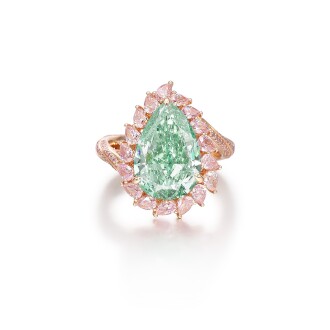T
his Autumn, Sotheby’s presents Magnificent Jewels: Part I in a live auction featuring the Queen Joséphine Necklace, once belonging to the exceptional royal collection of Queen Joséphine, The Ratnaraj of Mogok Ruby and Diamond Ring, an important jadeite carving and ‘The Star of Sierra Leone’ Diamond Brooch by Harry Winston, marking one of the most historically significant jewellery auctions ever to be hosted in Hong Kong. Iconic and fierce collections by Cartier and Van Cleef & Arpels can be seen alongside ever sought after coloured diamonds, gemstones and diamond pieces. From early 19th Century jewels to modern treasures, Magnificent Jewels: Part I will be one to discover.
Sale Highlights

Empress Joséphine’s Pearl Necklace
Natural pearls have been coveted throughout history. As symbols of love, beauty and power, they have been adored and admired by royalty across times and cultures. This superb early 19th century pearl and diamond necklace, also known as the Leuchtenberg Necklace, is attributed to Nitot, the founder of Chaumet. It once belonged to Augusta-Amélie of Bavaria, who was the daughter-in-law of Empress Joséphine—wife of Napoleon Bonaparte. It is conceivable the pearls came from the Empress as a gift or as a part of an inheritance. In fact, Augusta-Amélie and Empress Joséphine had a close relationship and was known to have given Augusta-Amélie jewels for display throughout her reign in the court. This necklace was eventually passed down to Augusta-Amélie’s daughter, also named Joséphine, who became the Queen of Sweden and Norway.

In the Qing Court, regulations were that only the emperor, empress dowager, and empress were permitted to wear adornments with Eastern pearls during certain ceremonies at the palace. An impressive example is the Eastern Pearl Court Beads that consists of 108 pearls made in the 17th century. Today, natural pearls are becoming increasingly rare as their original source is nearly depleted; and most saltwater pearls were harvested a hundred years ago. The natural pearls on this necklace are of superb quality and have a beautiful luster that has been maintained since the 19th century. It is extremely difficult to find a well-matched strand, and pearl necklaces of one row or more have always commanded legendary prices at auctions. Sotheby’s made headlines in 2018 for selling the most expensive natural pearl jewel: the pearl and diamond pendant once owned by Marie Antoinette in the collection of Royal Jewels from the Bourbon Parma Family. It was sold for CHF 36,427,000 against a pre-sale estimate of CHF 1,000,000 – 1,990,000.
This necklace was originally consigned to auction by the Swedish royal family in 1995 and was auctioned again in 2014 at Sotheby’s Geneva as ‘Queen Joséphine’s Pearl Necklace’. It has been exhibited a number of times, including the National Museum in Stockholm and more recently in Paris on Napoleon and Joséphine’s jewels by Chaumet. The necklace can be seen throughout a number of portraits of Princess Augusta-Amélie as well as her daughter Queen Joséphine of Sweden. It is truly special to be able to admire this historical natural pearl necklace with the portrait of the Queen, who is wearing the very same jewel. Queen Joséphine Necklace is the first time such a consequential jewel has been offered in Asia, and we believe it presents an exceptional opportunity for collectors.
Queen Joséphine Necklace | Property From An Exceptional Royal Collection


The “big three” stones of the coloured gem world are nature’s most precious treasures: ruby, sapphire, and emerald. In addition to delighting the eye, these gems have played an important role in the development of human civilisation. They are symbols of power and wealth, but they also convey a desire for love and luck or have been used to treat or strengthen the spirit.
The big three gems convey different meanings. Rubies and sapphires are part of the corundum family, which is second only to diamonds on the Mohs scale of mineral hardness. Rubies are known as the “prince of gemstones,” and they were often given pride of place in ancient religion and classic literature. Red symbolises passion and joy, and wearing rubies shows vitality and confidence.
Sapphires have the calm, tranquil hue of the vast ocean or pristine sky, representing insight and wisdom. In ancient Greece and Rome, sapphires were worn by royalty and members of the clergy to symbolise the union of man and the gods. Today, European royalty still favours sapphires for their refinement and elegance. The British royal family has a collection of large sapphires, and several members of the royal family have chosen sapphire engagement rings.
Emeralds are the most esteemed members of the beryl family, and the history of emerald mining can be traced back several thousand years. Cleopatra, the Queen of Egypt, was said to be fascinated by emeralds, and wore ornaments adorned with large numbers of these gemstones. In ancient India, emeralds were used to treat disease and ward off evil. For hundreds of years, the Incas utilized emeralds in jewellery and religious ceremonies. Emeralds have long been symbols of benevolence, luck, and rebirth; like the colour green, they represent the regeneration and growth of spring and the vitality of all living things.


































